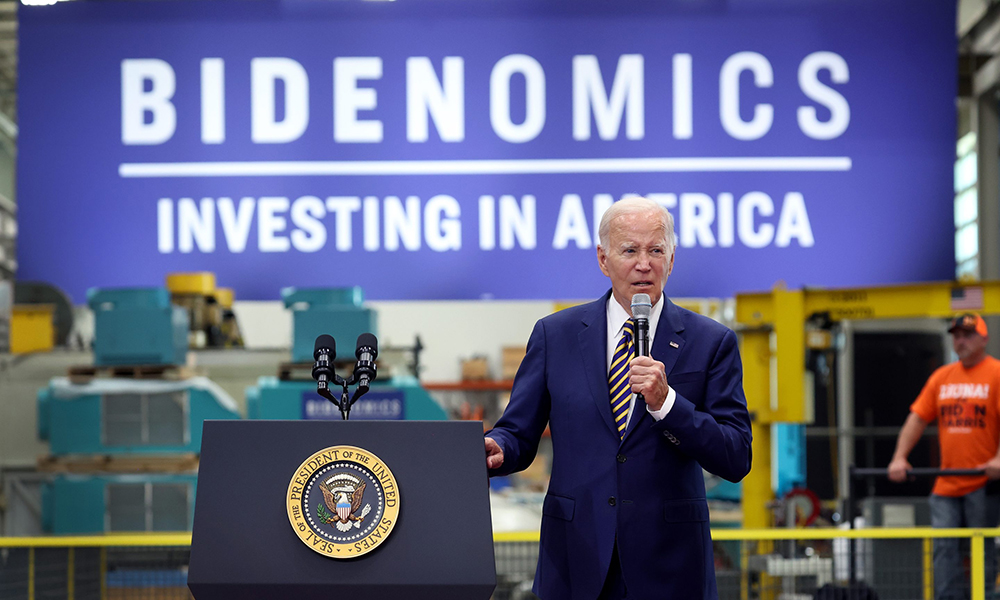哈佛经济学家认为,美国制造业复兴不会创造更多就业岗位

近几年来,制造业一直是中美两国科技竞争的核心战场,而且美国公司均希望将更多供应链转移到国内。
美国总统乔·拜登一直在兜售鼓励美国生产更多芯片和绿色能源技术的政策。本月早些时候,拜登政府承诺拨款66亿美元,以支持台积电(Taiwanese Semiconductor)在亚利桑那州扩建工厂。上个月,拜登政府与芯片业巨头英特尔(Intel)达成了一项195亿美元的资助协议,用于帮助英特尔在美国新建四家工厂。
但哈佛大学肯尼迪学院(Harvard Kennedy School)的国际政治经济教授丹尼·罗德里克认为,美国和其他全球制造业强国的数据表明,就业需要另当别论。
在项目辛迪加(Project Syndicate)发表的一篇评论文章中,这位经济学家指出,美国制造业的劳动生产力自1950年以来增长了近六倍,但其他经济领域的生产力仅翻了一番。
他写道:“结果是美国制造业生产商品的能力显著增强,但创造就业岗位的能力却急剧下降。”自1980年以来,美国制造业失去了600万个就业岗位。
罗德里克表示,在唐纳德·特朗普的总统任期内,尽管政府坚持“美国优先”的立场,并与中国发起了贸易战,但美国制造业在非农就业中所占的比例却从8.6%下滑至8.4%。
在拜登执政期间,尽管在《通胀削减法案》(Inflation Reduction Act)和《芯片与科学法案》(CHIPS and Science Act)通过后,政府向公司拨款数十亿美元,而且美国私营行业为新制造项目投入了超过2,000亿美元,但这个比例却进一步下滑至8.2%。
罗德里克表示:“怀疑论者可能会反驳说拜登政府的政策尚未完全见效,而且在官方统计数据中没有体现出来。但事实上,相比实际资金需求,资本密集型半导体工厂创造的就业机会很少。”
例如,台积电预计在亚利桑那州的新工厂将创造6,000个就业岗位,罗德里克计算每个新增岗位的成本超过1,000万美元。他表示,即使台积电的供应商还能再创造数万个就业岗位,但“这在就业方面的回报依旧微不足道”。
罗德里克还表示,德国和韩国的制造业在总就业人数方面的占比也有所下滑。在中国,工厂就业岗位无论是绝对数还是总就业人数占比,十多年来持续减少。
他说道:“自动化和技能偏好型技术,导致制造业不太可能像以前一样继续吸收劳动力。无论我们喜欢与否,零售、护理和其他个人服务等服务业,依旧是创造就业的主力。”
他总结道,不能说《芯片法案》和鼓励国内生产的类似政策存在缺陷,因为它们依旧可以刺激创新,但“重建中产阶级,创造足够多好的就业岗位,以及振兴衰败的区域,需要一套截然不同的政策。”(财富中文网)
译者:刘进龙
审校:汪皓
近几年来,制造业一直是中美两国科技竞争的核心战场,而且美国公司均希望将更多供应链转移到国内。
美国总统乔·拜登一直在兜售鼓励美国生产更多芯片和绿色能源技术的政策。本月早些时候,拜登政府承诺拨款66亿美元,以支持台积电(Taiwanese Semiconductor)在亚利桑那州扩建工厂。上个月,拜登政府与芯片业巨头英特尔(Intel)达成了一项195亿美元的资助协议,用于帮助英特尔在美国新建四家工厂。
但哈佛大学肯尼迪学院(Harvard Kennedy School)的国际政治经济教授丹尼·罗德里克认为,美国和其他全球制造业强国的数据表明,就业需要另当别论。
在项目辛迪加(Project Syndicate)发表的一篇评论文章中,这位经济学家指出,美国制造业的劳动生产力自1950年以来增长了近六倍,但其他经济领域的生产力仅翻了一番。
他写道:“结果是美国制造业生产商品的能力显著增强,但创造就业岗位的能力却急剧下降。”自1980年以来,美国制造业失去了600万个就业岗位。
罗德里克表示,在唐纳德·特朗普的总统任期内,尽管政府坚持“美国优先”的立场,并与中国发起了贸易战,但美国制造业在非农就业中所占的比例却从8.6%下滑至8.4%。
在拜登执政期间,尽管在《通胀削减法案》(Inflation Reduction Act)和《芯片与科学法案》(CHIPS and Science Act)通过后,政府向公司拨款数十亿美元,而且美国私营行业为新制造项目投入了超过2,000亿美元,但这个比例却进一步下滑至8.2%。
罗德里克表示:“怀疑论者可能会反驳说拜登政府的政策尚未完全见效,而且在官方统计数据中没有体现出来。但事实上,相比实际资金需求,资本密集型半导体工厂创造的就业机会很少。”
例如,台积电预计在亚利桑那州的新工厂将创造6,000个就业岗位,罗德里克计算每个新增岗位的成本超过1,000万美元。他表示,即使台积电的供应商还能再创造数万个就业岗位,但“这在就业方面的回报依旧微不足道”。
罗德里克还表示,德国和韩国的制造业在总就业人数方面的占比也有所下滑。在中国,工厂就业岗位无论是绝对数还是总就业人数占比,十多年来持续减少。
他说道:“自动化和技能偏好型技术,导致制造业不太可能像以前一样继续吸收劳动力。无论我们喜欢与否,零售、护理和其他个人服务等服务业,依旧是创造就业的主力。”
他总结道,不能说《芯片法案》和鼓励国内生产的类似政策存在缺陷,因为它们依旧可以刺激创新,但“重建中产阶级,创造足够多好的就业岗位,以及振兴衰败的区域,需要一套截然不同的政策。”(财富中文网)
译者:刘进龙
审校:汪皓
Manufacturing has been front and center in recent years as the U.S. and China engage in a tech rivalry while companies look to reposition more of their supply chains domestically.
President Joe Biden has touted his policies to encourage more U.S. production of chips and green-energy technologies. Earlier this month, his administration pledged up to $6.6 billion so that Taiwanese Semiconductor can expand its facilities in Arizona. And last month, the administration reached a $19.5 billion funding deal with chip giant Intel for four new U.S. plants.
But data in the U.S. and other global manufacturing powerhouses show that employment is another matter, according to Dani Rodrik, a professor of international political economy at Harvard Kennedy School.
In an op-ed published in Project Syndicate on Tuesday, the economist pointed out that labor productivity in U.S. manufacturing has surged by nearly six times since 1950, while the rest of the economy has seen productivity double.
“The result has been a striking increase in the manufacturing sector’s ability to produce goods, but also an equally dramatic decline in its capacity to generate jobs,” he wrote, with 6 million manufacturing jobs lost since 1980.
And despite an “America first” agenda and a trade war with China, U.S. manufacturing’s share of non-farm employment slipped to 8.4% from 8.6% while Donald Trump was president, Rodrik said.
That share has dipped further to 8.2% under Biden, even as the government doles out billions to companies and the U.S. private sector has committed over $200 billion to new manufacturing projects after his Inflation Reduction Act and the CHIPS and Science Act passed.
“A skeptic might object that Biden’s policies have not fully borne fruit and are not yet captured in official statistics,” Rodrik added. “But the fact is that hugely capital-intensive semiconductor plants generate few jobs, relative to the physical investment they require.”
At TSMC’s new plants in Arizona, for example, the company projects 6,000 jobs will be created, which Rodrik calculated would be more than $10 million per job. And even if tens of thousands of additional jobs among TSMC’s suppliers are created, “that is a paltry return for employment,” he said.
Similarly, manufacturing’s share of total employment has dropped in Germany and South Korea, Rodrik continued. And in China, factory jobs have been in decline for more than a decline, both in absolute terms and as a share total employment.
“Automation and skill-biased technology have made it extremely unlikely that manufacturing can become the labor-absorbing activity that it once was,” he said. “Whether we like it or not, services such as retail, care work, and other personal services will remain the primary engine of job creation.”
To be sure, the CHIPS Act and similar policies to encourage domestic production aren’t necessarily flawed, as they could still boost innovation, but “rebuilding the middle class, generating enough good jobs, and reinvigorating declining regions call for an entirely different set of policies,” he concluded.













